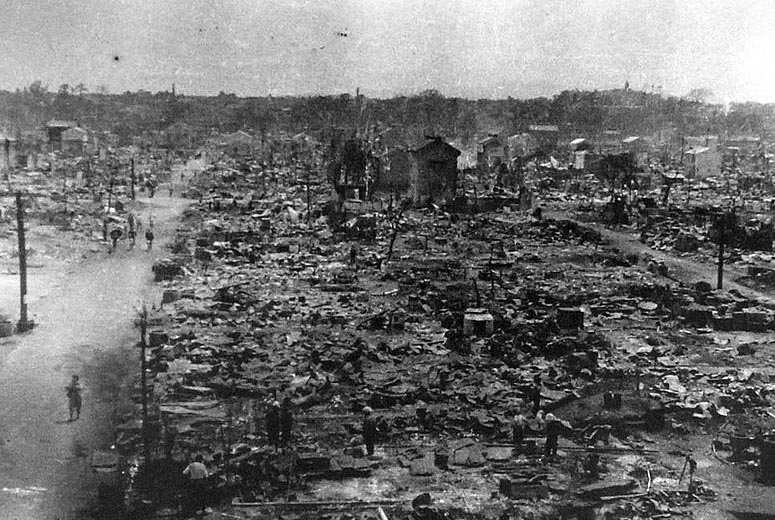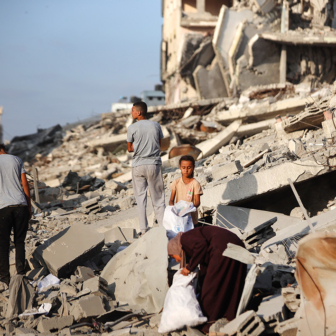Can the most destructive bombardment in world history be hiding in plain sight? It is tempting to make this claim about the onslaught on Tokyo by the US Air Force over the night of 9–10 March 1945 that resulted in the deaths of more than 100,000 people. The victims thus exceed those directly killed by the Hiroshima or Nagasaki atomic bombs in August, and by the British–American air raids on Dresden on 13–15 February (which a team of German historians now estimates at a maximum of 25,000).
Beyond numbers, the “great Tokyo air raid” (Tokyo daikushu) also has a singular horror. The tide of war had long turned decisively against Japan. The capture of the Mariana Islands in November 1944 had made it possible for America’s powerful B-29 bombers to launch long-range raids on its territory. Pounding attacks on the port city of Kobe and Tokyo itself in February, causing extensive damage, were a foretaste. To total air superiority and immense explosive power was added a change of tactics from high-altitude to lower-flying bombing. Three more ingredients completed the mix: clear skies, the preponderance of wood-and-paper buildings in the target areas (including the industrial flatlands in the city’s east), and strong winds conducive to the quick spread of fires. On a highly combustible city, 325 B-29s dropped around 2000 tons of incendiary bombs in two hours.
A recipe for carnage, then, from burning by napalm to suffocation by noxious smoke to laceration by molten glass. Individual fires met, and exploded into infernos. Many people sought relief in the river, only to be boiled to death, asphyxiated or drowned. There were few places to hide; shelters dug under homes were more often death traps. By early morning, the relentless barrage and conflagration had flattened much of the cityscape. Survivors buried relatives where they could, set up impromptu shrines, sought shelter and relief. Firefighters and hospitals continued to work against the odds. Officials made records, collated statistics, issued orders. The hard core of a militarised and police state pulled ever tighter around itself and over its exhausted citizens.
The air campaign was repeated across Japan over the ensuing weeks. Sixty-six urban centres were pulverised, at huge cost to lives and infrastructure. Each city, every neighbourhood, was afflicted from on high in its own way. Military options narrowed to last-ditch homeland defence, diplomatic ones to the desperate search for an exit short of absolute defeat, human ones to survival. Then, the double use of a “new and most cruel bomb” in early August led to political crisis and surrender from on high. Eight years of war were over. Japan entered the unknown.
What happened in Tokyo took its place among the many horrors of those years across the world. But where was that place? The short answer is, elusive at best. Inevitably, the brute realities of the war’s outcome imposed a taxonomy of suffering that would shape perceptions of the global conflict for years to come. The millions of dead Japanese and German civilians, including tens of thousands who in the immediate postwar period were slaughtered in or expelled from lands their armies had conquered, featured hardly at all.
In the convulsive era of occupation, cold war, and recovery after 1945, both winners and losers had a lot on their minds. Japanese and Germans gradually negotiated their way towards admission to the new order. There was little moralism and a lot of rationalisation. Most, consumed by the business of living, deferred a backward look. Memories were buried, discarded, revised, sentimentalised, privatised. And in circumstances of dependency and political constraint, much was either off limits or already taken care of. By the time the covers began to lift, and people could in principle think and speak more freely, many routes to the past were overgrown.
Tokyo boomed and bloomed. But the catastrophe that had visited the city in March 1945 remained largely out of sight. Indeed, each addition to the skyline made it more remote. When the Olympic Games in 1964 marked new Japan’s opening to the world, Tokyo celebrated its ability to rise from the depths. It was a way to enfold the century’s two colossal disasters, the “great Kanto earthquake” (Kanto daishinsai) of September 1923, whose toll was also well over 100,000, being the first. The link was real: in each case, incineration had consumed the wooden shacks of the working class “low city” (shitamachi) between the Sumida and Arakawa rivers.
There were other reasons for relative silence. The firebombing, though devastating, was a late episode in the war yet several months from its end. August’s climactic events would deliver to Hiroshima and Nagasaki an unwanted, existential status as both “victim” and “peace” cities. Tokyo escaped that fate and the dilemmas it entails. The calamity and its dead, however, were left in the margins of remembrance.
In the atomic cities, Hiroshima especially (Nagasaki had more going for it), politicised memory was an unavoidable drag. But there was a certain convenience for Japan’s elite that the main symbol of national suffering, and site of pietistic peace pilgrimage, was far from the capital. Sustained memorialisation of Tokyo’s experience of war might invite unwelcome questions, not least about Japan’s own aerial assaults, from Chongqing in 1938–43 to the late madness of suicide planes. Better let tortured souls lie.
Or else exhume them for a cynical purpose. Yushukan is the museum attached to the Yasukuni shrine (jinja) in central Tokyo. A bronze statue of one of those kamikaze pilots, erected in 2005, lurks on a plinth in a discreet corner a few yards from the entrance. It’s an augury for the tendentious panorama of national history inside, whose later stages in particular mix grotesquerie and farce. As I exited into the teeming crowds (it was the new year holiday), the odd, perhaps essentialist but somehow apt thought struck me that this was the most un-Japanese place I had ever visited in Japan.
Elsewhere there is relief. The Edo-Tokyo museum, in Sumida ward, has a discerning section on Tokyoites’ exposure to war in the context of the city’s multilayered history. And a ten-minute walk from Yushukan, the 300,000 unidentified Japanese soldiers and civilians from the war in Asia are recalled at the Chidorigafuchi national cemetery. A panel maps numbers, dates and locations. In the middle of the sedate park is a hexagonal hall, open to the elements, with a ceramic coffin at the centre. The remains are housed in subterranean ossuaries. There is room to breathe. It is deserted.
Two sites of memory bring the firebombing closest. In quiet Yokoami park, also in Sumida, the Tokyo Memorial Hall (Tokyo-to Ireido) is the de facto official monument to the victims. The three-storey building in pagoda style had been rededicated in 1930 to those killed in the earthquake seven years earlier; many thousands who sought refuge in the park had been consumed by the firestorm sparked by the quake. Their ashes were joined in the postwar years by those of the victims of the fire bombing, a symbolism made formal in 1951. Respective ceremonies are held here every 1 September and 10 March.
The scaffolding is up in preparations for the seventieth anniversary. Inside is tranquil, the rows of hard chairs suggestive of a lecture theatre. In a corner, the visitor can switch on a ten-minute video, pulled from the public broadcaster NHK, telling the story of the 1945 raid. Along the walls, enlarged photos of desolation: a group gathered round a water pump, a family dragging a cart with their possessions. Beside the hall is a memorial artwork sculpted in 2001: a landscaped amphitheatre, its focal point is a small pond and a door into the dark.
The other site, to the south in Koto ward, is the independent Center of the Tokyo Raids and War Damage (Tokyo Daikushu Sensai Shiryo Senta). This modest institution was founded in 2002 by Saotome Katsumoto, a tireless educator and author of many books about the air raid, prominent among them The Day Tokyo Burned (Tokyo ga moeta hi), published in 1979. Its vast archive includes rare artefacts, meticulous documentary records, and survivors’ testimonies, accessible in its library and museum run by a small team of dedicated volunteers. Much of its work is research, publishing and outreach to schools, citizen groups and media. Katsumoto-san, now eighty-two, is invited to give talks all over Japan, the on-duty volunteer told me before taking a call from NHK about an anniversary program it was making.
Here is the collection of images, thirty-three in all, seen in part at Yokoami. They were taken by the young photographer Koyo Ishikawa, whose prewar Leica-shot street scenes rank with his great French and Hungarian peers. On 10 March, commissioned by Tokyo’s police department to record the impact of the raid, Ishikawa produced a haunting portfolio of tragedy. It survived only because he buried the negatives, thus ignoring the occupation authorities’ order that all such materials should be handed over.
The centre is a precious resource, all the more for retaining the spirit of its founder. That from-below and civic example continues to inflect understanding of one of the last century’s most terrible events. Every wave of renewed interest, whether expressed in exhibitions, advocacy, articles, websites, or support for recognition, owes Saotome Katsumoto and his colleagues a profound debt.
If not a hidden or forgotten atrocity, then, the great Tokyo air raid is certainly an under-remembered one. All the more reason to retrieve, compare and debate it. When East Asia’s future is uncertain and tensions over history acute, that might be thought impolitic. But much more harm is caused on every side by avoiding reality than facing it. Even seventy years on, Tokyo 1945 is an unhealed wound. •




